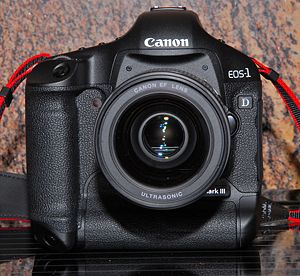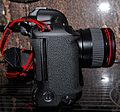
Canon EOS is an autofocus single-lens reflex camera (SLR) and mirrorless camera series produced by Canon Inc. Introduced in 1987 with the Canon EOS 650, all EOS cameras used 35 mm film until October 1996 when the EOS IX was released using the new and short-lived APS film. In 2000, the D30 was announced, as the first digital SLR designed and produced entirely by Canon. Since 2005, all newly announced EOS cameras have used digital image sensors rather than film. The EOS line is still in production as Canon's current digital SLR (DSLR) range, and, with the 2012 introduction of the Canon EOS M, Canon's mirrorless interchangeable-lens camera (MILC) system. In 2018 the system was further extended with the introduction of the EOS R camera, Canon's first full frame mirrorless interchangeable lens system.

The Canon EOS 20D is an 8.2-megapixel semi-professional digital single-lens reflex camera, initially announced on 19 August 2004 at a recommended retail price of US$1,499. It is the successor of the EOS 10D, and was succeeded by the EOS 30D in August 2006. It accepts EF and EF-S lenses and uses an APS-C sized image sensor.

The EOS-1Ds Mark II is a digital SLR camera body introduced by Canon Inc. in 2004. It was the top model in the Canon EOS line of digital cameras until April 2007, with a full-frame 16.7 megapixel CMOS sensor. The EOS-1Ds Mark II had the highest pixel count available in a 35mm format digital SLR at the time of its introduction until its successor was announced in August 2007. It uses the EF lens mount. The EOS-1Ds Mark II is a professional grade camera body and is large, ruggedly built, and dust/weather-resistant.

The EOS-1Ds is a full-frame 11.1-megapixel digital SLR camera body made by Canon in the 1Ds series, released on 24 September 2002. It was Canon's first full-frame DSLR. Its dimensions are 156 x 157.6 x 79.9 mm and mass is 1,265 g.
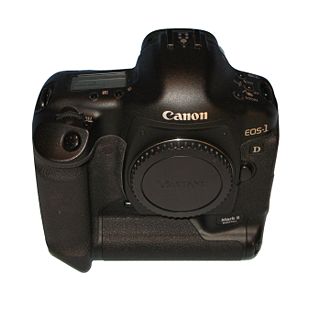
The EOS 1D Mark II is a professional 8.2 megapixel digital single lens reflex camera (DSLR) camera body produced by Canon. The EOS 1D Mark II was the successor of the EOS 1D and was itself replaced by the Canon EOS-1D Mark III in 2007. It was Canon's first dual-card slot EOS camera with one CF slot and one SD slot that was meant easily to use two dominant card types and have a assurance that once a small sized primary and faster CF slot is full, camera can be used to take photographs when recording was continued on secondary and slower card in critical moment. It also now had wireless capabilities. When paired with the new Canon WFT-E1, you could transfer images to a PC using an FTP server.

The EOS 5D is a 12.8 megapixel digital single-lens reflex (DSLR) camera body produced by Canon. The EOS 5D was announced by Canon on 22 August 2005, and at the time was priced above the EOS 20D but below the EOS-1D Mark II and EOS-1Ds Mark II in Canon's EOS digital SLR series. The camera accepts EF lens mount lenses.

The Canon EOS 40D is a 10.1-megapixel semi-professional digital single-lens reflex camera. It was initially announced on 20 August 2007 and was released at the end of that month. It is the successor of the Canon EOS 30D, and is succeeded by the EOS 50D. It can accept EF and EF-S lenses. Like its predecessor, it uses an APS-C sized image sensor, resulting in a 1.6x field of view crop factor.

The EOS-1Ds Mark III is a digital SLR camera body by Canon designed for professional photographers. The Canon EOS 1Ds Mark III is successor to the EOS-1Ds Mark II and was announced in August 2007. The camera features a full-frame 21.1 megapixel CMOS sensor with 14-bit analog/digital converters for a total colour depth of 16,384 tones per pixel. It features a three-inch LCD screen, capable of "Live View," and dual DIGIC III processors allowing it to shoot at up to five frames per second.
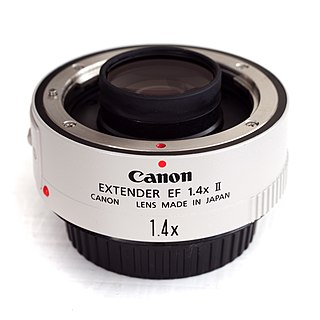
The Canon Extender EF lenses are a group of teleconverter lenses made by Canon. These lenses are used between any compatible EF type lens and any of the Canon EOS line of cameras. When used with a compatible lens, they will multiply the focal length of the lens by a factor of either 1.4x or 2x, at the cost of decreasing the lens' aperture by 1 or 2 stops respectively. For example, using a 1.4x or 2x extender with the Canon EF 500mm f/4L IS USM would result in a 700mm f/5.6 or 1000mm f/8 lens.

The Canon EOS 50D is a 15.1-megapixel digital single-lens reflex camera. It is part of the Canon EOS line of cameras, succeeding the EOS 40D and preceding the EOS 60D.

The Canon EOS 500D is a 15-megapixel entry-level digital single-lens reflex camera, announced by Canon on 25 March 2009. It was released in May 2009. It is known as the EOS Kiss X3 in Japan, and as the EOS Rebel T1i in North America. It continues the Rebel line of mid-range DSLR cameras, is placed by Canon as the next model up from the EOS 450D, and has been superseded by the EOS 550D (T2i).

The Canon EOS 7D is a cropped sensor digital single-lens reflex camera made by Canon. It was announced on 1 September 2009 with a suggested retail price of US$1,699. Among its features are an 18.0 effective megapixel CMOS sensor, HD video recording, its 8.0 frames per second continuous shooting, new viewfinder which offers 1.0X magnification and 100% coverage, 19-point auto-focus system, movie mode, and built-in Speedlite transmitter.

The EOS-1D Mark IV is a professional 16.1 effective megapixels digital single lens reflex camera (DSLR) camera body produced by Canon. The EOS-1D Mark IV is the successor of the Canon EOS-1D Mark III and was announced on 20 October 2009, just four days after Nikon announced the D3s. It is currently the only Canon APS-H format DSLR to feature HD video recording at 1080p resolution.

The Canon EOS-1D X is a professional digital SLR camera body by Canon Inc. It succeeded the company's previous flagship Canon EOS-1Ds Mark III and the Canon EOS-1D Mark IV. It was announced on 18 October 2011.
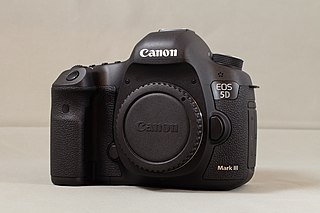
The Canon EOS 5D Mark III is a professional-grade 22.3 megapixels full-frame digital single-lens reflex (DSLR) camera made by Canon.
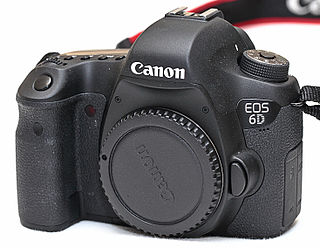
The Canon EOS 6D is a 20.2-megapixel full-frame CMOS digital single-lens reflex camera made by Canon.
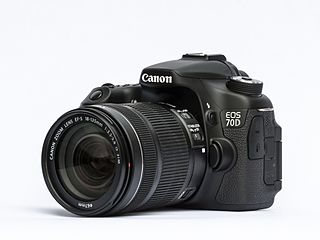
The Canon EOS 70D is a digital single-lens reflex camera by Canon publicly announced on July 2, 2013 with a suggested retail price of $1,199. As a part of the Canon EOS two-digit line, it is the successor to the EOS 60D and is the predecessor of the EOS 80D.

The EOS-1Ds is a series of full-frame digital SLR camera bodies made by Canon, first released on 24 September 2002. The series was replaced in March 2012 with the 1D X.

The Canon EOS 80D is a digital single-lens reflex camera announced by Canon on February 18, 2016. It has a body-only MSRP of US$1199, which is the same as the Canon EOS 70D, which it replaces. The camera can be purchased as a body-only, as kit with the 18-55mm IS STM lens at US$1,049, with the new 18-135mm IS USM lens at US$1,799 or with the EF-S 18-200mm IS at US$1,899.

In 1989, Canon released a single lens reflex camera, the EOS-1. It utilized new technologies found in the slightly earlier EOS-650, in a professional level body, of which, many of its unique, distinctive characteristics are still found today in more recent versions of its series. Numerous accessories were also available to boost performance and battery life.
